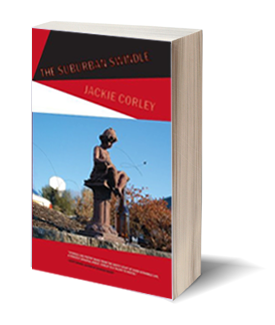The Suburban SwindleBy Jackie Corley |
 |
|---|
Reviewed by John Madera
When Kate Braverman was asked about her use of the color blue in Squandering the Blue, she responded that the “idea was to write a short story collection that was so interconnected, that the stories became more than the sum of their parts,” and she explained that the use of blue was the “secret for holding the twelve stories together,” that the use of themes was the way “to make a book of short stories worthy of history.”
Jackie Corley similarly sutures her stories together in The Suburban Swindle, her debut collection, with recurring themes, words, and symbols. As Corley vividly explores the persistence of violence—how it enters every dark and secret corner of a life, how it struggles against the failure of memory—you can see her reaching out for some kind of lexicon to begin to describe it, some set of symbolic obsessions with which to contain and control her conjured world.
For instance, just as Samuel Delany has a thing for feet or how Gary Lutz obsesses over arms, Corley always returns to the thumb. In “Persons of Bondage,” a witness recounts a person’s beating at a failed gas station, saying, “I could feel the pulse in my thumb and the scene curved right fresh in front of eyes that were holy and were mine,” while in the title story a woman rubs “the smooth valley along the bridge of [a boy’s] nose with [her] thumb.” The boys in “Catfish Boys,” “have a fat thumb stroking… the weedy patches on their chins, with dirt under the nails and in the maps of their finger pads,” and one boy there gets his hand sliced by a girlfriend, so that it “looked orange and raw when she did it to him, like a bruised peach when someone jabs a thumb into the ooze.”
While there is much focus on the flesh, on blood and sex, there’s also much reflection on the spirit or soul, or whatever you want to call the intangible. This aspect of The Suburban Swindle made me think of Allen Ginsberg’s Howl where benzedrine-fueled outcasts travel to the “holy Bronx” and see “Visions! omens! hallucinations! miracles! ecstasies!” Though all of Corley’s stories take place on the polluted streets and “sterile turnpikes” of New Jersey, it’s also where “God cut through somebody’s soul and spread his hands across the clouds. It hovers there, that swollen wound in the sky, the skin stretched thin and pursing at the gash.” Although an uncle in “The Suburban Swindle,” is recalled as failing to reach his heart when he stabbed himself with a knife, he did spill “all his holy breath.” It’s also where you find “bored, drippy-eyed potheads in basements anesthetizing their gods’ minds.” In “The Smoker in Winter,” a woman reflects: “Used to be we were lovers. Used to be there was something of God in that.” And the narrator in “Catfish Boys” opines, “Maybe it’s the midnight shuffle we carry in us, thick and slow, or the fading waitresses and their bitter glory, but spirits melt into diner walls just as strong as they do into graveyard soil.”
It’s not only awareness that these men and women are seeking, but transformation, maybe even transfiguration. From “Dancing Jesus at the Broadway Diner”:
She wants to see down the rolls of the hills, to see across the river and into town and know that every part of it is blood and concrete and throbbing. She wants to see it and stand immortal and let it wash away under her feet. She wants the knowledge, but only because she wants to know it so well that it would become irrelevant. No words. No thoughts. No emotion. But fullness. Something that spreads through her, through the living and the dead, from chaos to calm, warm, knowing nothing.
But there’s more to The Suburban Swindle than its convincing seaming together of themes. After all, there’s more to great writing than connecting the dots of motif, theme, and symbol. While Corley certainly uses themes and imagery to tie all of her stories together, her employment of them is never heavy-handed; they are skillfully enmeshed and always serve the forward momentum of the story, and create even more questions then they answer.
Corley’s stories repeatedly bring us back to the body, to blood and sex. However, this focus on the body does not stop her from reflecting just as precisely on the intangible, or from finding it in the unlikeliest of places. Corley’s stories make you forget where you are and take you somewhere else. And while where she takes us is often sordid and cold, blank and gray, peopled by lovers and fools (sometimes the two indistinguishable from each other), desperados and inamoratos, boys instead of men, tough talkers and the walking wounded, you never feel like you’re left alone. Like Braverman’s Squandering the Blue, Corley’s interconnected stories here are more than the sum of their parts, and she too has made “a book of short stories worthy of history.” Moreover, The Suburban Swindle reminds us that words are a kind of solace, stories a kind of guide, and books a kind of salvation.
